2009 INFINITI QX56 air condition
[x] Cancel search: air conditionPage 3733 of 4171
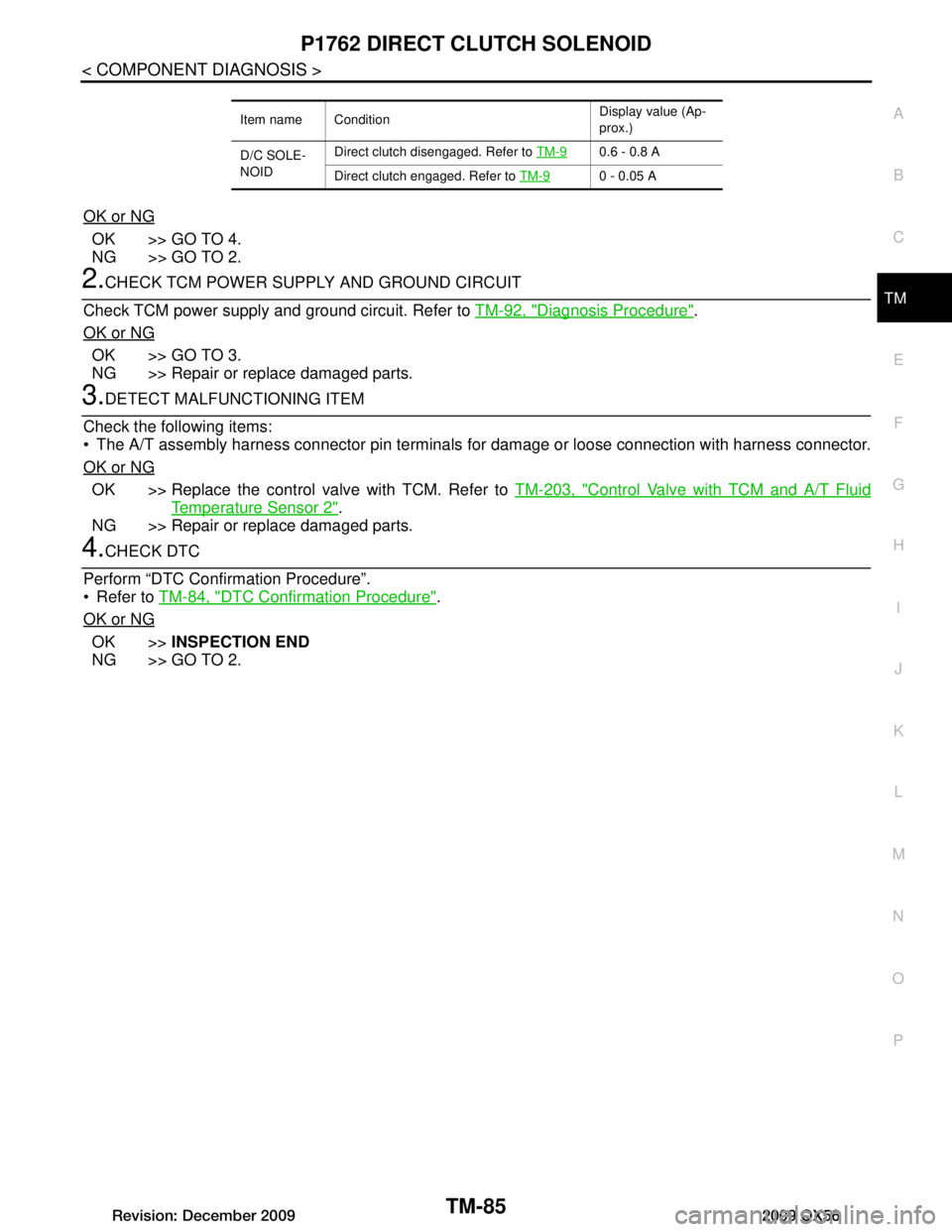
P1762 DIRECT CLUTCH SOLENOIDTM-85
< COMPONENT DIAGNOSIS >
CEF
G H
I
J
K L
M A
B
TM
N
O P
OK or NG
OK >> GO TO 4.
NG >> GO TO 2.
2.CHECK TCM POWER SUPPLY AND GROUND CIRCUIT
Check TCM power supply and ground circuit. Refer to TM-92, "Diagnosis Procedure"
.
OK or NG
OK >> GO TO 3.
NG >> Repair or replace damaged parts.
3.DETECT MALFUNCTIONING ITEM
Check the following items:
The A/T assembly harness connector pin terminals for damage or loose connection with harness connector.
OK or NG
OK >> Replace the control valve with TCM. Refer to TM-203, "Control Valve with TCM and A/T Fluid
Temperature Sensor 2".
NG >> Repair or replace damaged parts.
4.CHECK DTC
Perform “DTC Confirmation Procedure”.
Refer to TM-84, "DTC Confirmation Procedure"
.
OK or NG
OK >> INSPECTION END
NG >> GO TO 2.
Item name Condition Display value (Ap-
prox.)
D/C SOLE-
NOID Direct clutch disengaged. Refer to
TM-9
0.6 - 0.8 A
Direct clutch engaged. Refer to TM-9
0 - 0.05 A
Revision: December 20092009 QX56
Page 3734 of 4171
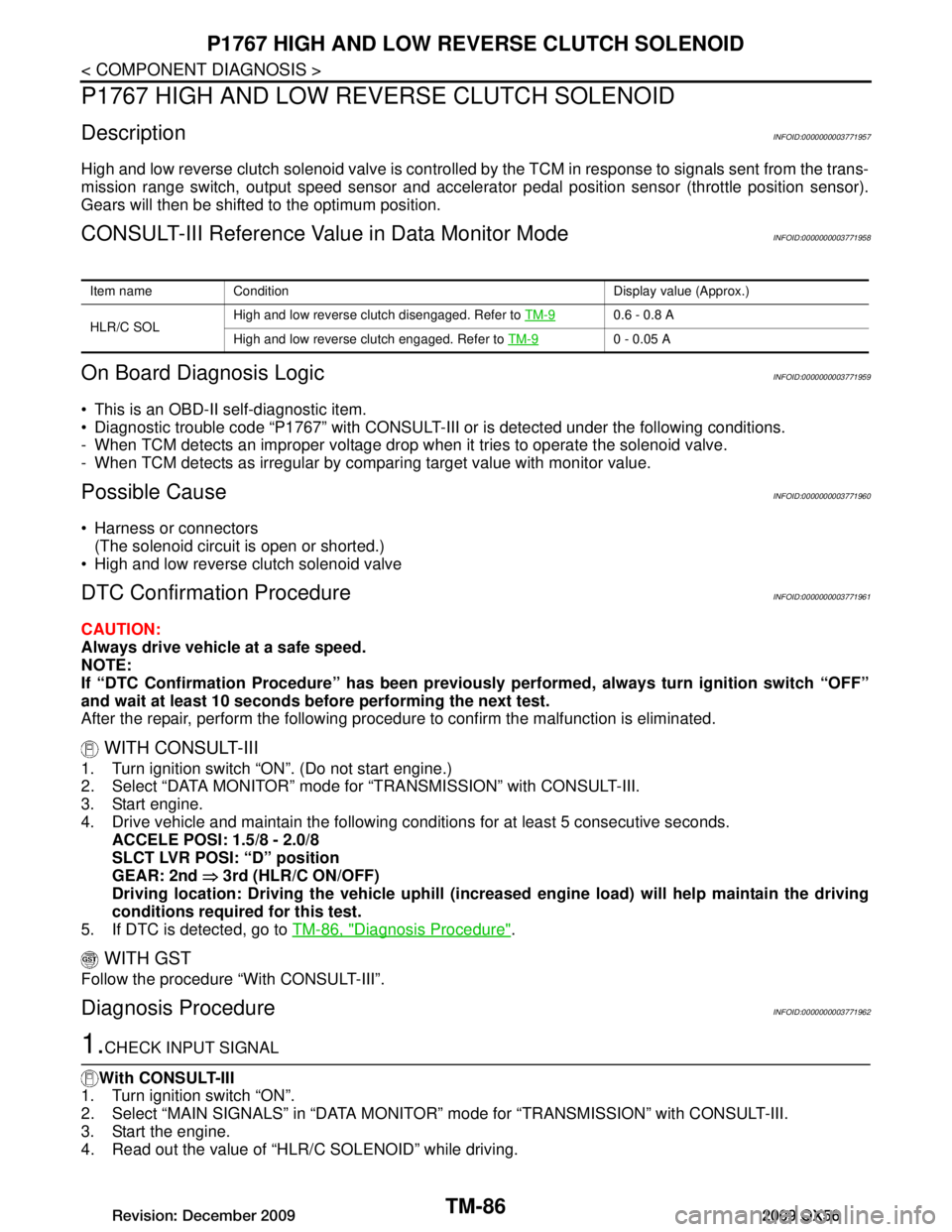
TM-86
< COMPONENT DIAGNOSIS >
P1767 HIGH AND LOW REVERSE CLUTCH SOLENOID
P1767 HIGH AND LOW REVERSE CLUTCH SOLENOID
DescriptionINFOID:0000000003771957
High and low reverse clutch solenoid valve is controlled by the TCM in response to signals sent from the trans-
mission range switch, output speed sensor and accelerato r pedal position sensor (throttle position sensor).
Gears will then be shifted to the optimum position.
CONSULT-III Reference Value in Data Monitor ModeINFOID:0000000003771958
On Board Diagn osis LogicINFOID:0000000003771959
This is an OBD-II self-diagnostic item.
Diagnostic trouble code “P1767” with CONSULT-III or is detected under the following conditions.
- When TCM detects an improper voltage drop when it tries to operate the solenoid valve.
- When TCM detects as irregular by comparing target value with monitor value.
Possible CauseINFOID:0000000003771960
Harness or connectors
(The solenoid circuit is open or shorted.)
High and low reverse clutch solenoid valve
DTC Confirmation ProcedureINFOID:0000000003771961
CAUTION:
Always drive vehicle at a safe speed.
NOTE:
If “DTC Confirmation Procedure” has been previously performed, always turn ignition switch “OFF”
and wait at least 10 seconds before performing the next test.
After the repair, perform the following proc edure to confirm the malfunction is eliminated.
WITH CONSULT-III
1. Turn ignition switch “ON”. (Do not start engine.)
2. Select “DATA MONITOR” mode for “TRANSMISSION” with CONSULT-III.
3. Start engine.
4. Drive vehicle and maintain the following conditions for at least 5 consecutive seconds.
ACCELE POSI: 1.5/8 - 2.0/8
SLCT LVR POSI: “D” position
GEAR: 2nd ⇒ 3rd (HLR/C ON/OFF)
Driving location: Driving the vehicle uphill (increased engine load) will help maintain the driving
conditions required for this test.
5. If DTC is detected, go to TM-86, "Diagnosis Procedure"
.
WITH GST
Follow the procedure “With CONSULT-III”.
Diagnosis ProcedureINFOID:0000000003771962
1.CHECK INPUT SIGNAL
With CONSULT-III
1. Turn ignition switch “ON”.
2. Select “MAIN SIGNALS” in “DATA MONITO R” mode for “TRANSMISSION” with CONSULT-III.
3. Start the engine.
4. Read out the value of “HLR/C SOLENOID” while driving.
Item name Condition Display value (Approx.)
HLR/C SOL High and low reverse clutch disengaged. Refer to
TM-9
0.6 - 0.8 A
High and low reverse clutch engaged. Refer to TM-9
0 - 0.05 A
Revision: December 20092009 QX56
Page 3735 of 4171
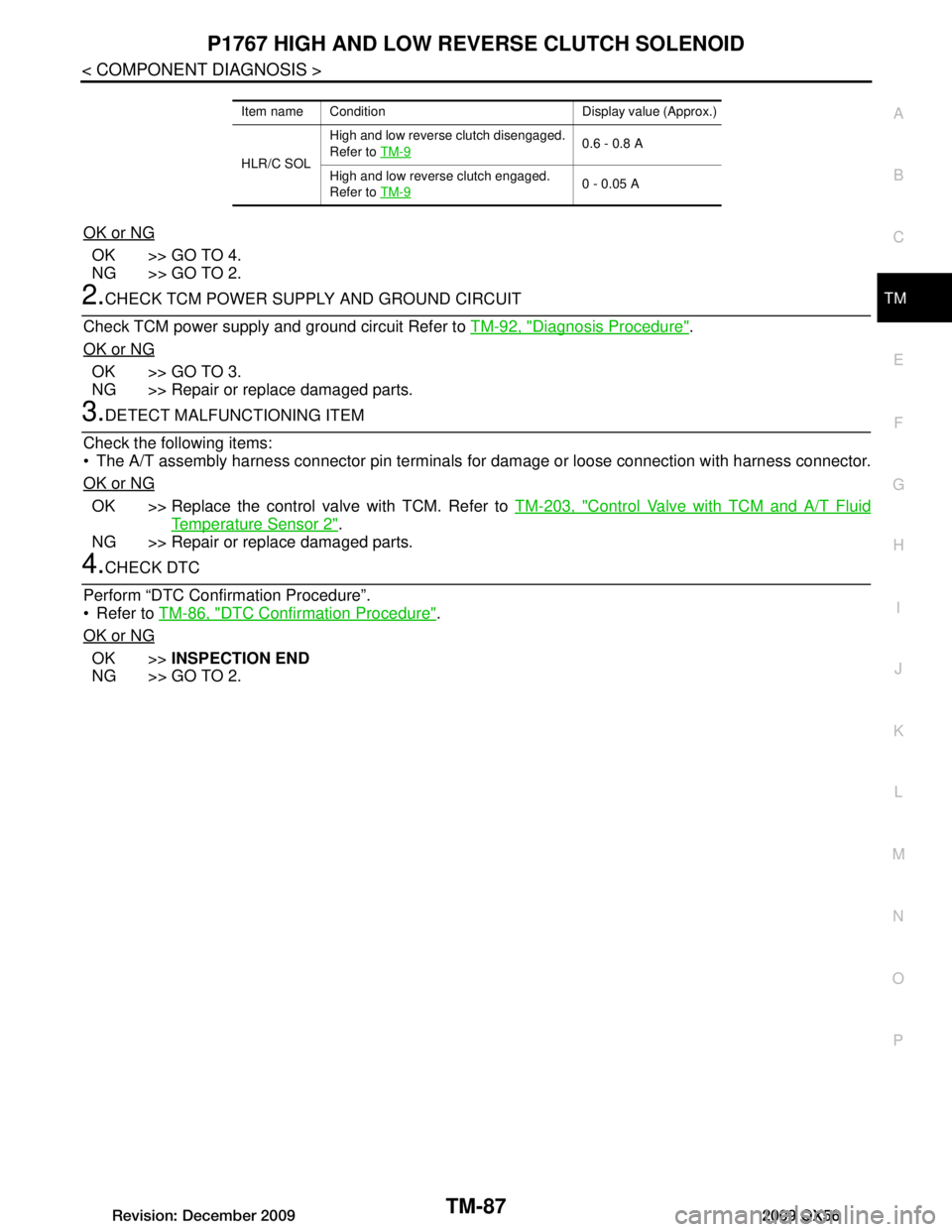
P1767 HIGH AND LOW REVERSE CLUTCH SOLENOID
TM-87
< COMPONENT DIAGNOSIS >
C EF
G H
I
J
K L
M A
B
TM
N
O P
OK or NG
OK >> GO TO 4.
NG >> GO TO 2.
2.CHECK TCM POWER SUPPLY AND GROUND CIRCUIT
Check TCM power supply and ground circuit Refer to TM-92, "Diagnosis Procedure"
.
OK or NG
OK >> GO TO 3.
NG >> Repair or replace damaged parts.
3.DETECT MALFUNCTIONING ITEM
Check the following items:
The A/T assembly harness connector pin terminals for damage or loose connection with harness connector.
OK or NG
OK >> Replace the control valve with TCM. Refer to TM-203, "Control Valve with TCM and A/T Fluid
Temperature Sensor 2".
NG >> Repair or replace damaged parts.
4.CHECK DTC
Perform “DTC Confirmation Procedure”.
Refer to TM-86, "DTC Confirmation Procedure"
.
OK or NG
OK >> INSPECTION END
NG >> GO TO 2.
Item name Condition Display value (Approx.)
HLR/C SOL High and low reverse clutch disengaged.
Refer to
TM-9
0.6 - 0.8 A
High and low reverse clutch engaged.
Refer to TM-9
0 - 0.05 A
Revision: December 20092009 QX56
Page 3736 of 4171
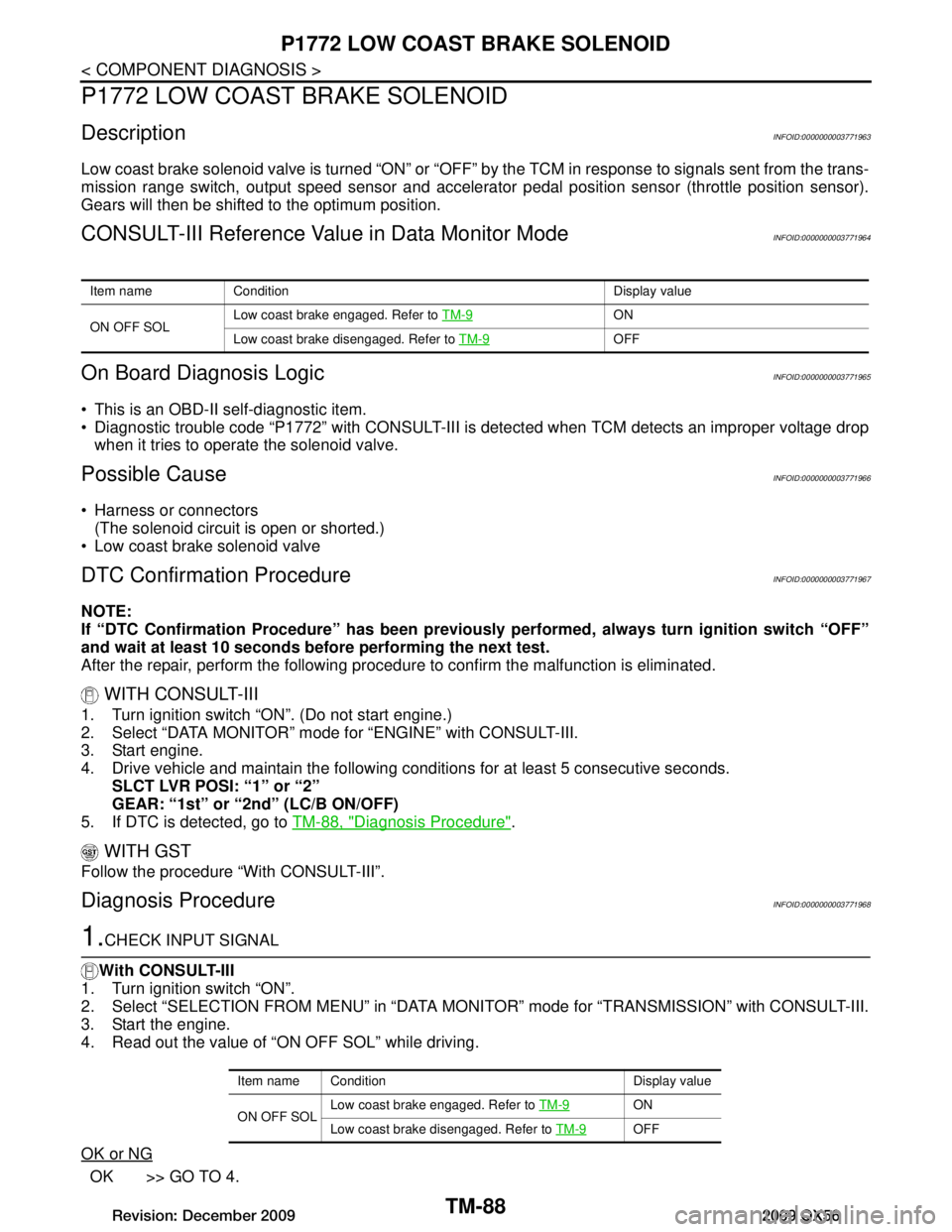
TM-88
< COMPONENT DIAGNOSIS >
P1772 LOW COAST BRAKE SOLENOID
P1772 LOW COAST BRAKE SOLENOID
DescriptionINFOID:0000000003771963
Low coast brake solenoid valve is turned “ON” or “OFF” by the TCM in response to signals sent from the trans-
mission range switch, output speed sensor and accelerato r pedal position sensor (throttle position sensor).
Gears will then be shifted to the optimum position.
CONSULT-III Reference Value in Data Monitor ModeINFOID:0000000003771964
On Board Diagn osis LogicINFOID:0000000003771965
This is an OBD-II self-diagnostic item.
Diagnostic trouble code “P1772” with CONSULT-III is detected when TCM detects an improper voltage drop
when it tries to operate the solenoid valve.
Possible CauseINFOID:0000000003771966
Harness or connectors (The solenoid circuit is open or shorted.)
Low coast brake solenoid valve
DTC Confirmation ProcedureINFOID:0000000003771967
NOTE:
If “DTC Confirmation Procedure” has been previously performed, always turn ignition switch “OFF”
and wait at least 10 seconds before performing the next test.
After the repair, perform the following proc edure to confirm the malfunction is eliminated.
WITH CONSULT-III
1. Turn ignition switch “ON”. (Do not start engine.)
2. Select “DATA MONITOR” mode for “ENGINE” with CONSULT-III.
3. Start engine.
4. Drive vehicle and maintain the following conditions for at least 5 consecutive seconds.
SLCT LVR POSI: “1” or “2”
GEAR: “1st” or “2nd” (LC/B ON/OFF)
5. If DTC is detected, go to TM-88, "Diagnosis Procedure"
.
WITH GST
Follow the procedure “With CONSULT-III”.
Diagnosis ProcedureINFOID:0000000003771968
1.CHECK INPUT SIGNAL
With CONSULT-III
1. Turn ignition switch “ON”.
2. Select “SELECTION FROM MENU” in “DATA MONI TOR” mode for “TRANSMISSION” with CONSULT-III.
3. Start the engine.
4. Read out the value of “ON OFF SOL” while driving.
OK or NG
OK >> GO TO 4.
Item name Condition Display value
ON OFF SOL Low coast brake engaged. Refer to
TM-9
ON
Low coast brake disengaged. Refer to TM-9
OFF
Item name Condition Display value
ON OFF SOLLow coast brake engaged. Refer to
TM-9
ON
Low coast brake disengaged. Refer to TM-9
OFF
Revision: December 20092009 QX56
Page 3738 of 4171
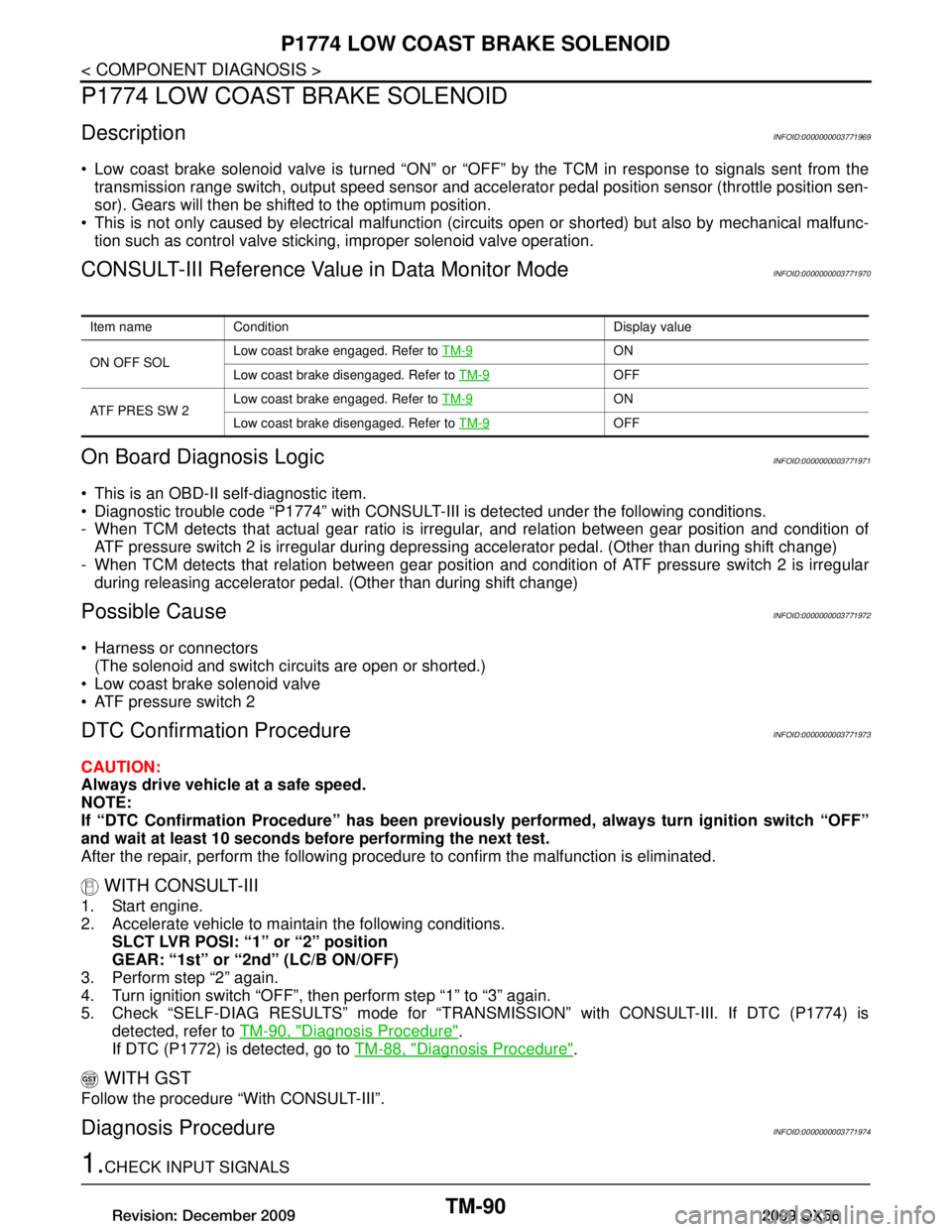
TM-90
< COMPONENT DIAGNOSIS >
P1774 LOW COAST BRAKE SOLENOID
P1774 LOW COAST BRAKE SOLENOID
DescriptionINFOID:0000000003771969
Low coast brake solenoid valve is turned “ON” or “OFF” by the TCM in response to signals sent from the
transmission range switch, output speed sensor and accele rator pedal position sensor (throttle position sen-
sor). Gears will then be shifted to the optimum position.
This is not only caused by electrical malfunction (cir cuits open or shorted) but also by mechanical malfunc-
tion such as control valve sticking, improper solenoid valve operation.
CONSULT-III Reference Value in Data Monitor ModeINFOID:0000000003771970
On Board Diagn osis LogicINFOID:0000000003771971
This is an OBD-II self-diagnostic item.
Diagnostic trouble code “P1774” with CONSULT-III is detected under the following conditions.
- When TCM detects that actual gear ratio is irr egular, and relation between gear position and condition of
ATF pressure switch 2 is irregular during depressing accelerator pedal. (Other than during shift change)
- When TCM detects that relation between gear position and condition of ATF pressure switch 2 is irregular
during releasing accelerator pedal. (Other than during shift change)
Possible CauseINFOID:0000000003771972
Harness or connectors
(The solenoid and switch circuits are open or shorted.)
Low coast brake solenoid valve
ATF pressure switch 2
DTC Confirmation ProcedureINFOID:0000000003771973
CAUTION:
Always drive vehicle at a safe speed.
NOTE:
If “DTC Confirmation Procedure” has been previously performed, always turn ignition switch “OFF”
and wait at least 10 seconds before performing the next test.
After the repair, perform the following proc edure to confirm the malfunction is eliminated.
WITH CONSULT-III
1. Start engine.
2. Accelerate vehicle to maintain the following conditions.
SLCT LVR POSI: “1” or “2” position
GEAR: “1st” or “2nd” (LC/B ON/OFF)
3. Perform step “2” again.
4. Turn ignition switch “OFF”, then perform step “1” to “3” again.
5. Check “SELF-DIAG RESULTS” mode for “TRANS MISSION” with CONSULT-III. If DTC (P1774) is
detected, refer to TM-90, "Diagnosis Procedure"
.
If DTC (P1772) is detected, go to TM-88, "Diagnosis Procedure"
.
WITH GST
Follow the procedure “With CONSULT-III”.
Diagnosis ProcedureINFOID:0000000003771974
1.CHECK INPUT SIGNALS
Item name Condition Display value
ON OFF SOLLow coast brake engaged. Refer to
TM-9
ON
Low coast brake disengaged. Refer to TM-9
OFF
ATF PRES SW 2 Low coast brake engaged. Refer to
TM-9
ON
Low coast brake disengaged. Refer to TM-9
OFF
Revision: December 20092009 QX56
Page 3739 of 4171
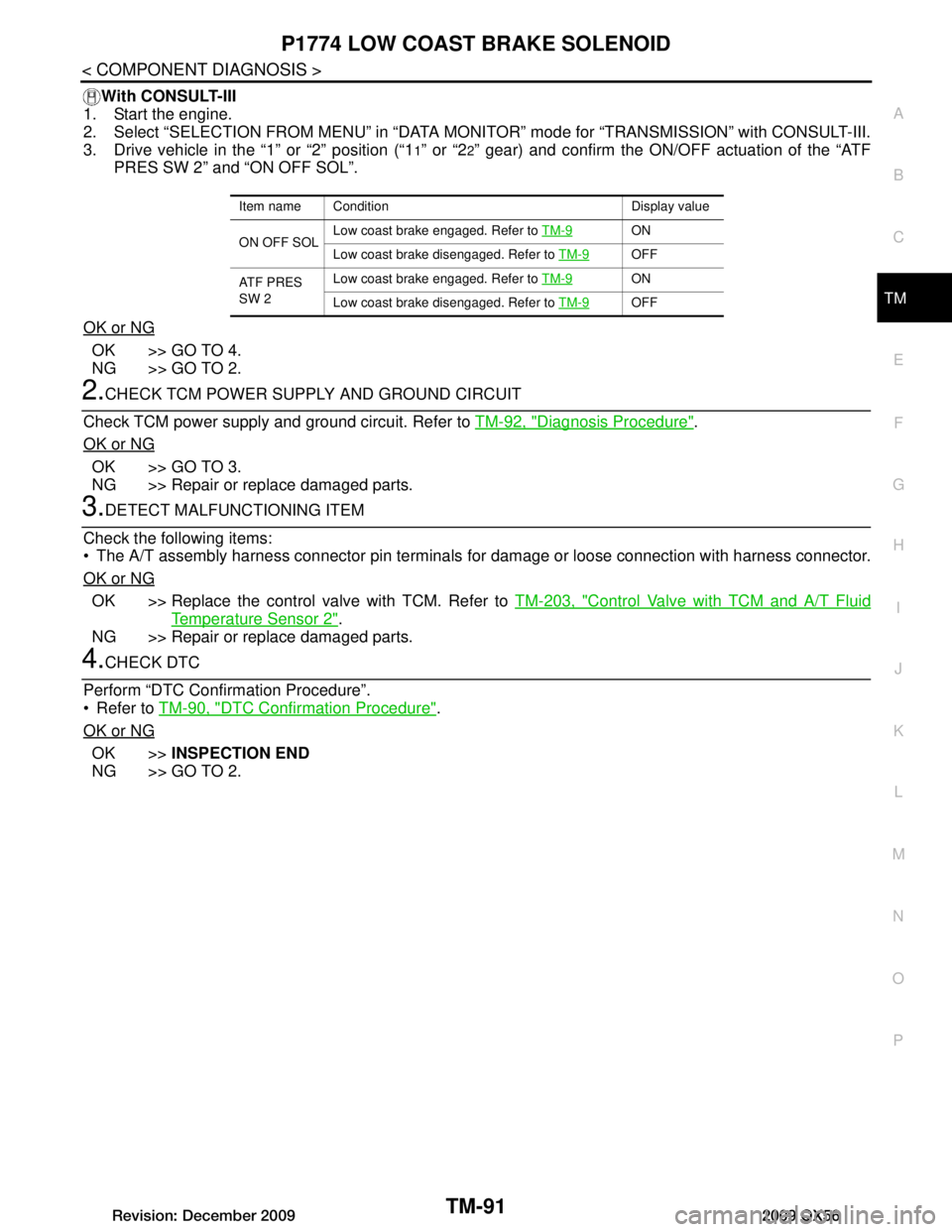
P1774 LOW COAST BRAKE SOLENOIDTM-91
< COMPONENT DIAGNOSIS >
CEF
G H
I
J
K L
M A
B
TM
N
O P
With CONSULT-III
1. Start the engine.
2. Select “SELECTION FROM MENU” in “DATA MONI TOR” mode for “TRANSMISSION” with CONSULT-III.
3. Drive vehicle in the “1” or “2” position (“1
1” or “22” gear) and confirm the ON/OFF actuation of the “ATF
PRES SW 2” and “ON OFF SOL”.
OK or NG
OK >> GO TO 4.
NG >> GO TO 2.
2.CHECK TCM POWER SUPPLY AND GROUND CIRCUIT
Check TCM power supply and ground circuit. Refer to TM-92, "Diagnosis Procedure"
.
OK or NG
OK >> GO TO 3.
NG >> Repair or replace damaged parts.
3.DETECT MALFUNCTIONING ITEM
Check the following items:
The A/T assembly harness connector pin terminals for damage or loose connection with harness connector.
OK or NG
OK >> Replace the control valve with TCM. Refer to TM-203, "Control Valve with TCM and A/T Fluid
Temperature Sensor 2".
NG >> Repair or replace damaged parts.
4.CHECK DTC
Perform “DTC Confirmation Procedure”.
Refer to TM-90, "DTC Confirmation Procedure"
.
OK or NG
OK >> INSPECTION END
NG >> GO TO 2.
Item name Condition Display value
ON OFF SOL Low coast brake engaged. Refer to
TM-9
ON
Low coast brake disengaged. Refer to TM-9
OFF
ATF PRES
SW 2 Low coast brake engaged. Refer to
TM-9
ON
Low coast brake disengaged. Refer to TM-9
OFF
Revision: December 20092009 QX56
Page 3742 of 4171
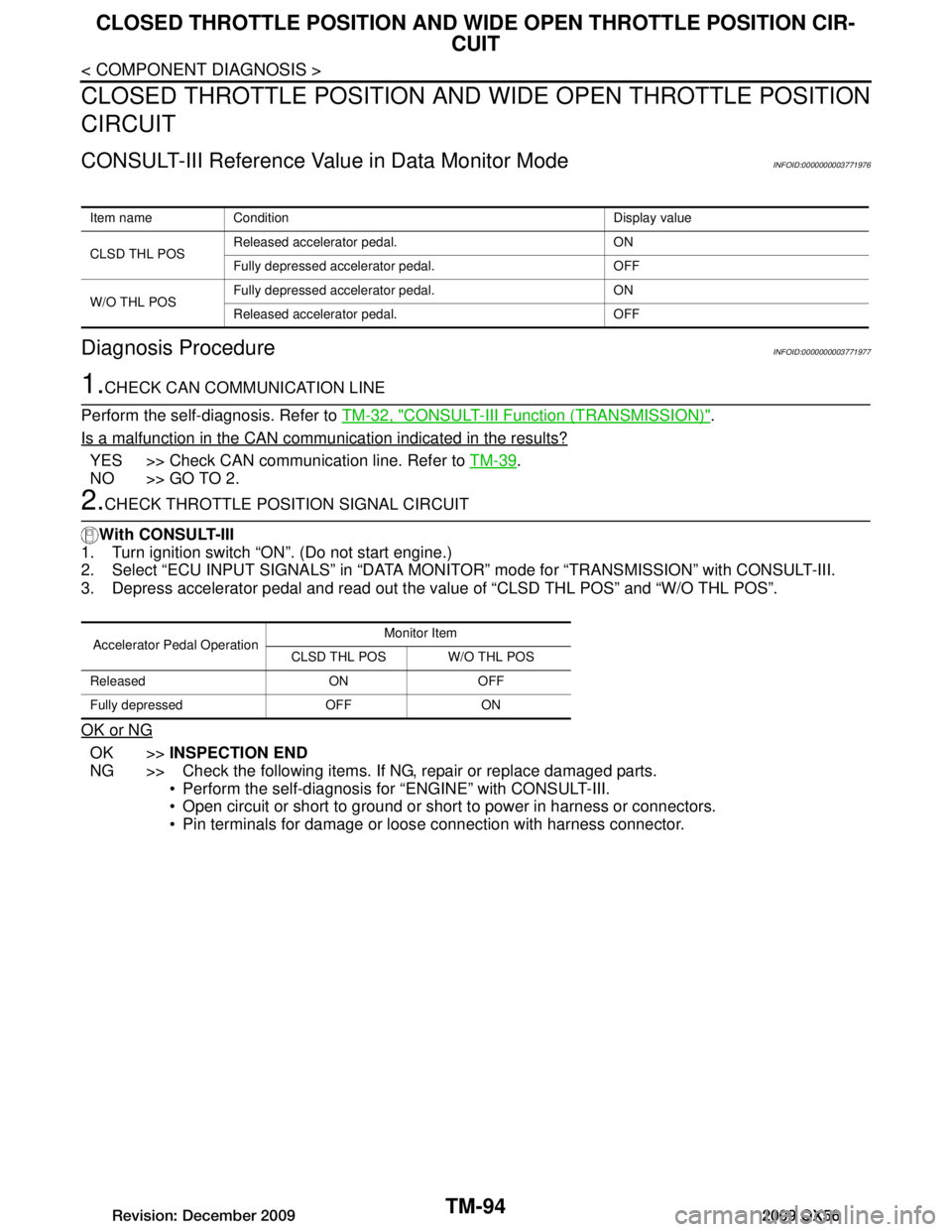
TM-94
< COMPONENT DIAGNOSIS >
CLOSED THROTTLE POSITION AND WIDE OPEN THROTTLE POSITION CIR-
CUIT
CLOSED THROTTLE POSITION AND WIDE OPEN THROTTLE POSITION
CIRCUIT
CONSULT-III Reference Value in Data Monitor ModeINFOID:0000000003771976
Diagnosis ProcedureINFOID:0000000003771977
1.CHECK CAN COMMUNICATION LINE
Perform the self-diagnosis. Refer to TM-32, "CONSULT-III Function (TRANSMISSION)"
.
Is a malfunction in the CAN communication indicated in the results?
YES >> Check CAN communication line. Refer to TM-39.
NO >> GO TO 2.
2.CHECK THROTTLE POSI TION SIGNAL CIRCUIT
With CONSULT-III
1. Turn ignition switch “ON”. (Do not start engine.)
2. Select “ECU INPUT SIGNALS” in “DATA MONI TOR” mode for “TRANSMISSION” with CONSULT-III.
3. Depress accelerator pedal and read out the value of “CLSD THL POS” and “W/O THL POS”.
OK or NG
OK >> INSPECTION END
NG >> Check the following items. If NG, repair or replace damaged parts. Perform the self-diagnosis for “ENGINE” with CONSULT-III.
Open circuit or short to ground or shor t to power in harness or connectors.
Pin terminals for damage or loos e connection with harness connector.
Item name Condition Display value
CLSD THL POSReleased accelerator pedal. ON
Fully depressed accelerator pedal. OFF
W/O THL POS Fully depressed accelerator pedal. ON
Released accelerator pedal. OFF
Accelerator Pedal Operation Monitor Item
CLSD THL POS W/O THL POS
Released ON OFF
Fully depressed OFF ON
Revision: December 20092009 QX56
Page 3743 of 4171
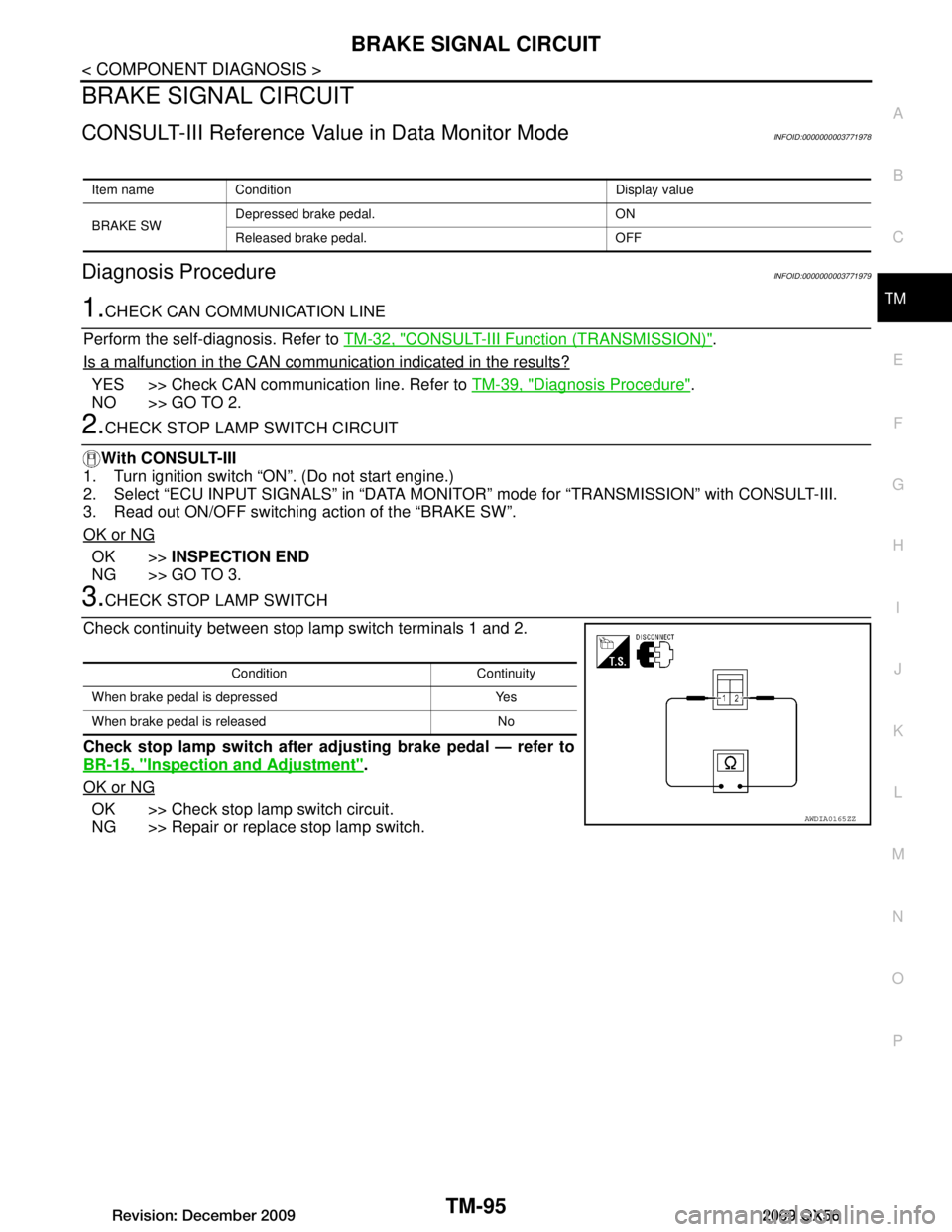
BRAKE SIGNAL CIRCUITTM-95
< COMPONENT DIAGNOSIS >
CEF
G H
I
J
K L
M A
B
TM
N
O P
BRAKE SIGNAL CIRCUIT
CONSULT-III Reference Val ue in Data Monitor ModeINFOID:0000000003771978
Diagnosis ProcedureINFOID:0000000003771979
1.CHECK CAN COMMUNICATION LINE
Perform the self-diagnosis. Refer to TM-32, "CONSULT-III Function (TRANSMISSION)"
.
Is a malfunction in the CAN communication indicated in the results?
YES >> Check CAN communication line. Refer to TM-39, "Diagnosis Procedure".
NO >> GO TO 2.
2.CHECK STOP LAMP SWITCH CIRCUIT
With CONSULT-III
1. Turn ignition switch “ON”. (Do not start engine.)
2. Select “ECU INPUT SIGNALS” in “DATA MONITO R” mode for “TRANSMISSION” with CONSULT-III.
3. Read out ON/OFF switching action of the “BRAKE SW”.
OK or NG
OK >> INSPECTION END
NG >> GO TO 3.
3.CHECK STOP LAMP SWITCH
Check continuity between stop lamp switch terminals 1 and 2.
Check stop lamp switch after adjusting brake pedal — refer to
BR-15, "Inspection and Adjustment"
.
OK or NG
OK >> Check stop lamp switch circuit.
NG >> Repair or replace stop lamp switch.
Item name Condition Display value
BRAKE SW Depressed brake pedal. ON
Released brake pedal. OFF
Condition Continuity
When brake pedal is depressed Yes
When brake pedal is released No
AWDIA0165ZZ
Revision: December 20092009 QX56